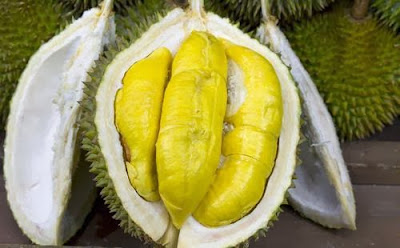Papaya contains a lot of nutrients, even very rich in vitamin C. One papaya fruit contains at least 235 mg of vitamin C. The amount is 2-3 times more than recommended daily recommendations.
Not only that, papaya also contains other nutrients needed by the body, namely vitamin A, vitamin B1, B3, B5, vitamin E, vitamin K, lycopene, fiber, calcium, potassium, folate, and magnesium. With a myriad of these nutrients, papaya provides so many health benefits.
Variety of Benefits Papaya
Some people may know papaya as a fruit that can facilitate digestion. But actually there are various benefits of papaya for health and beauty you need to know:
a). Healthy eyes.
Papaya contains vitamin A which is good for the eyes. Vitamin A is needed for corneal health and produces enough moisture to keep the eyes well lubricated.
b). Healthy hair and nails.
Papaya is rich in vitamins and minerals that help promote hair and nail growth. This orange fruit can even be used as a hair mask to nourish hair.
c). Heals sunburned skin.
Papaya contains a substance called lycopene. According to research, consuming lycopene can maintain healthy skin because antioxidant activity of this substance play in preventing cell damage caused by free radical.
d). Streamlining digestion.
Do you know why papaya is famous for digestion? This is because papaya contains papain enzymes that make proteins more easily digested. According to research, consuming papaya for 40 days allegedly can cure constipation and flatulence.
e). Heart health.
Papaya containing vitamin C and lycopene can be one of the foods that help reduce the risk of heart disease. In addition, antioxidants in papaya can also increase the effects of good cholesterol (HDL) in the body.
f). Reduce the risk of cancer.
Papaya contain lycopene antioxidants that can reduce cancer-free radicals.
g). Antiaging.
Various nutrients in papaya are able to keep skin healthy and look young. For example papain enzymes that help soften and revitalize the skin, as well as vitamins A and C that help reduce wrinkles and dull black spots. Not only that, vitamin C is also useful to help the body produce collagen which can reduce wrinkles.
h). Boost the immune system.
Vitamins A, C, and E in papaya can help strengthen the immune system. The result, we also avoid infectious diseases, such as colds and flu.
i). Good for dengue fever.
Papaya allegedly have a good impact on diseases caused by dengue virus that can suppress platelet counts. Research shows dengue infection patients who get papaya leaf extract have increased platelets faster than those who get regular treatment. However, this effect still needs to be investigated clinically further.
If you do not have allergies to papaya and the ingredients in it, start to eat this one fruit to experience the benefits of papaya mentioned above. By adding papaya in your daily menu, your body's nutritional intake will increase and you can avoid some diseases.
Not only that, papaya also contains other nutrients needed by the body, namely vitamin A, vitamin B1, B3, B5, vitamin E, vitamin K, lycopene, fiber, calcium, potassium, folate, and magnesium. With a myriad of these nutrients, papaya provides so many health benefits.
Variety of Benefits Papaya
Some people may know papaya as a fruit that can facilitate digestion. But actually there are various benefits of papaya for health and beauty you need to know:
a). Healthy eyes.
Papaya contains vitamin A which is good for the eyes. Vitamin A is needed for corneal health and produces enough moisture to keep the eyes well lubricated.
b). Healthy hair and nails.
Papaya is rich in vitamins and minerals that help promote hair and nail growth. This orange fruit can even be used as a hair mask to nourish hair.
c). Heals sunburned skin.
Papaya contains a substance called lycopene. According to research, consuming lycopene can maintain healthy skin because antioxidant activity of this substance play in preventing cell damage caused by free radical.
d). Streamlining digestion.
Do you know why papaya is famous for digestion? This is because papaya contains papain enzymes that make proteins more easily digested. According to research, consuming papaya for 40 days allegedly can cure constipation and flatulence.
e). Heart health.
Papaya containing vitamin C and lycopene can be one of the foods that help reduce the risk of heart disease. In addition, antioxidants in papaya can also increase the effects of good cholesterol (HDL) in the body.
f). Reduce the risk of cancer.
Papaya contain lycopene antioxidants that can reduce cancer-free radicals.
g). Antiaging.
Various nutrients in papaya are able to keep skin healthy and look young. For example papain enzymes that help soften and revitalize the skin, as well as vitamins A and C that help reduce wrinkles and dull black spots. Not only that, vitamin C is also useful to help the body produce collagen which can reduce wrinkles.
h). Boost the immune system.
Vitamins A, C, and E in papaya can help strengthen the immune system. The result, we also avoid infectious diseases, such as colds and flu.
i). Good for dengue fever.
Papaya allegedly have a good impact on diseases caused by dengue virus that can suppress platelet counts. Research shows dengue infection patients who get papaya leaf extract have increased platelets faster than those who get regular treatment. However, this effect still needs to be investigated clinically further.
If you do not have allergies to papaya and the ingredients in it, start to eat this one fruit to experience the benefits of papaya mentioned above. By adding papaya in your daily menu, your body's nutritional intake will increase and you can avoid some diseases.




























